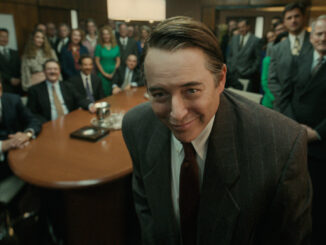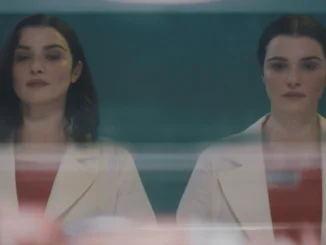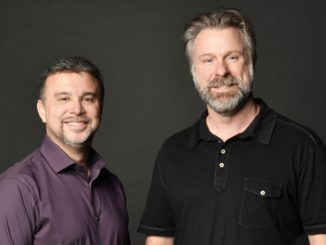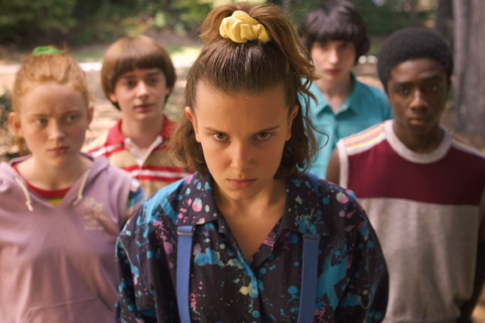
The editing secrets behind Netflix’s smash series
By Peter Tonguette
You don’t have to be a rabid consumer of 1980s-era popular culture to work on the Netflix science-fiction series “Stranger Things.” But it doesn’t hurt.
When editor Dean Zimmerman, ACE, was first offered the job of editing the popular series about the intersection of suburbia and the supernatural during the time of the Reagan Administration, he was reluctant to leave behind the career in feature films that he had been steadily developing. “Being a feature editor, and that being my world for so long … there were other options on the horizon that seemed to be more in line of what I was consistently doing,” Zimmerman said.
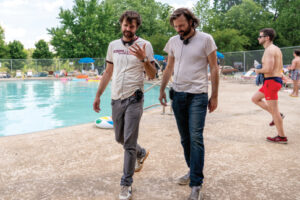
Then the 46-year-old editor — who came of age at a time when such series touchstones as “E.T. the Extra-Terrestrial” (1982), “The Thing” (1982), and “Ghostbusters” (1984) were first seen in movie theaters — sat down to read the script by the Duffer Brothers, the show’s creators and frequent directors.
“Every page I was reading, I was like, ‘Stand by Me’ — literally I kept rattling off every single movie that impacted my entire youth,” Zimmerman said. “When I met the Duffers, it was not necessarily an interview of, ‘Hey do you want the job?’” Instead, Zimmerman told the brothers he simply had to do the job.
Zimmerman hopped aboard the “Stranger Things” train starting with Episode 1 of Season 1, “The Vanishing of Will Byers.” That episode put into play many of the elements that would rivet viewers over the course of Seasons 2 and 3 (a fourth season was announced before production was suspended due to the COVID-19 outbreak earlier this year).
The show revolves around the paranormal occurrences — including the disappearance of young Will Byers (Noah Schnapp) into a dimension familiar to fans as the “Upside Down” — that come close to overwhelming Hawkins, Indiana. Winona Ryder stars as the mother of Will and his sibling, Jonathan (Charlie Heaton). A group of Will’s friends — Mike (Finn Wolfhard), Dustin (Gaten Matarazzo), and Lucas (Caleb McLaughlin) — also have major parts.
Of course, “Stranger Things” has taken numerous detours and digressions since that debut episode, but Zimmer-man has been a constant presence in the cutting room; he now divides each sea-son’s load of episodes with fellow picture editor Nat Fuller, who began on the series as an assistant editor on Season 1.
“First and foremost, Dean is simply a great editor — he has a great grasp of characters, tone, he’s always got a solution, and he’s full of some seriously mind-blowing tricks,” said the Duffer Brothers (who consist of 36-year-old twins Matt and Ross Duffer). “He’s half-editor, half-magician. He’s also insanely fast, which helps — and he knows what you want halfway through your sentence, like he’s psychic or something. You’re still talking and his fingers are already flying across that keyboard.”
Zimmerman joined “Stranger Things” on the recommendation of executive producer and director Shawn Levy, with whom the editor had worked on a spate of successful comedies, including “Night at the Museum: Battle of the Smithsonian” (2009), “Date Night” (2010), and “The Internship” (2013).
“He is an invaluable career-long collaborator of mine,” Levy said. “In fact, I think the very first piece of big-brother producerial advice I ever gave the Duffer Brothers was, ‘Hire this editor Dean, because he is going to be a core franchise player for us!’”
Editing plays a crucial role on “Stranger Things” in establishing and maintaining the overall feel of the series. Scenes are not reimagined wholesale on “Stranger Things,” but instead finessed, fussed-over, and made just so. “Our episodes tend to reflect the Duffers’ writing, with very few scene omits or restructuring,” Levy said. “But, in the same breath, I would add that our post-production pipeline is immensely critical to the DNA of ‘Stranger Things’ in several key ways. Our episodes are so performance-centric, rhythm-based, and pace-reliant, and tone is everything.”
The Duffers call editing their favorite part of the process. “It seems like almost anything is possible in editorial,” the brothers said. “It never ceases to amaze us how much you can reshape a scene with the right cut, the right music, and the right sound.” Zimmerman added: “This is where they really love to dig in, spend the time, and polish the material.”
From the beginning, Zimmerman instituted an editorial workflow that merged processes from the worlds of feature films and episodic content. In tandem with his fellow editor on Season 1, Kevin D. Ross, ACE, Zimmerman devised a system that involved locking individual episodes early on but holding off on finishing work until the season could be viewed in totality. “All the sound and music and color timing and all the technical aspects that happen to the show, we do at the end,” Zimmerman said. “It yields us the time to be able to go back into other episodes earlier on to fine-tune them.”
‘My guilty pleasure is watching those people who videotape themselves watching the episodes on YouTube.’
For example, during the shooting of Episodes 7 and 8 on Season 1, Zimmerman and his then-assistant editor Fuller realized that those episodes could benefit from the addition of a new scene in Episode 1. “We talked to them about it, and they were able to shoot that for Episode 1 while they were shooting the last couple of episodes,” Zimmerman said. “We were allowed to play in the sandbox and get as dirty as we wanted to without any repercussions because they just wanted us to be as creative as possible and tell the best story.”
While Fuller, who moved up to picture editor on Season 2, divides episodes with Zimmerman, the colleagues often scrutinize each other’s work in an attempt to create a single, unified body of work — not just a random grab-bag of episodes. “Dean will be cutting half the episodes, and I’ll be cutting half the episodes,” Fuller said. “Once Dean has it into a place where the brothers have watched it, I’ll sit down and watch just his episode and I’ll be like, ‘Oh, that isn’t quite paying off as well because I need to go back into my episode and maybe set that up a little bit better.’… We’re always working as a whole.”
Early in his tenure on Season 2, Fuller was responsible for cutting one of the most talked-about sequences in the history of the series: a montage depicting members of the young cast posing in their proton-pack-laden “Ghostbusters” outfits as they gear up for Halloween.
“When I watched it, I remember calling Nat and going, ‘You killed it, man — knocked it out of the park,’” Zimmerman recalled. “I literally was flashing back to ‘Ghostbusters.’” Yet, Fuller said, the scene was already ultra-nostalgic as written and directed — his job was just to make it sing. “In that particular montage, I was just like, ‘Let’s just make this fun,’” said Fuller, who, like the rest of the team, is a fan of 1980s movies, but who never seeks to emulate the film grammar of the era in his cutting. The nostalgia is baked into the original footage. “I can’t recall ever feeling like I’m purposely trying to make it a certain ’80s style,” Fuller said.
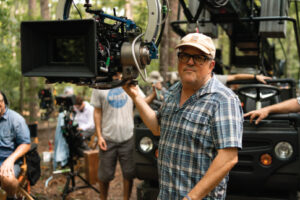
Indeed, both editors say they are free to let the footage take them in unexpected directions. Sometimes, that has yielded important discoveries that have influenced the direction of the storytelling.
When cutting Episode 1 of Season 1, Zimmerman sat down to work on a dramatic scene in which Mike — one of Will’s friends — is seen at the dinner table with his family. As the discussion between Mike and his parents pivot from the matter of Will’s disappearance to the new boyfriend of his sister, Nancy (Natalia Dyer), their younger sibling, Holly, looks on. Zimmerman decided to anchor the scene with reaction shots of the toddler, who bobs her head back and forth as arguments intensify among her elders and siblings.
“I basically told the story of that scene through the eyes of the little girl,” said Zimmerman, who reversed shots and rotoscoped-out actors to make the scene work. “This is a very serious scene… Let’s let them laugh at this scene, so that we can then punch them in the face with something later that they won’t be expecting.”
After looking over the scene as assembled by Zimmerman, the Duffer Brothers realized the value of alleviating serious scenes with laughs, a mix they adhered to in future episodes. “That then became a window for the Duffers to go, ‘Oh, wait a minute — we actually do need comedy in this series because that is what’s going to sustain us and make people engage more,’” Zimmerman said.
In addition to the routine duties of their jobs, including receiving, managing, and prepping dailies for Zimmerman and Fuller, first assistant editors Casey Cichocki and Kat Naranjo are often called upon to lay in temp sound design. “Even more so than any show I’ve been a part of, the sound is so important, and there is a certain level of expectation even as early as the director first laying eyes on it in a rough assembly or a first editor’s pass,” Cichocki said. “It’s just trying to lay in that base and start making it sound and feel like ‘Stranger Things.’”
The rest is up to sound supervisor and re-recording mixer Craig Henighan, MPSE. In fact, his initial assignment was to dream up vocalizations for the Demogorgon creature. “I just took it upon myself to make a few different ideas of what maybe the Demogorgon could sound like,” said Henighan, who sent the sample MP3 file to the Duffer Brothers, then shooting the first episode. “They called me back one night and they’re like, ‘Oh my God. We were shooting all day and then we come back to the offices…and then we play these crazy monster sounds. This is awesome.’ That’s basically how our relationship started.”
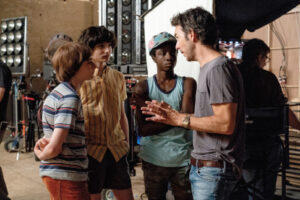
When it came time to pin down the sound of the Demogorgon, Henighan first experimented with non-mammalian sounds — using the creaking of a door — but ultimately turned to his own library of seal sounds. “There was one little sound that, as I was just sort of listening through the library, I was like, ‘Oh, that’s kind of interesting,’” said Henighan, who used those sounds to build a variety of vocalizations for the monster. “Out of that, I was able to sort of grow the different types of roars and gurgles and snarls and growls.”
The Duffers describe the sounds concocted by Henighan as “incredibly unique.” “If he’s heard a sound before in a movie or show, he’s just not interested,” the creators said. “He’s breathed incredible personality into the Upside Down and its many monsters, bringing them to roaring life.” Of course, not every sound is big and bold. Especially during Season 1, Henighan was tasked with creating a subtler soundscape emerging from the not-quite-right town of Hawkins. “In the early episodes, you didn’t quite figure out what was going on,” he said. “If you listen closely to the insects or the background atmosphere, . . . they’re sometimes pitched a lot lower, or they’re sometimes reversed and there’s a heaviness to it.”
The “Stranger Things” editorial crew say that Season 3 — set during the summertime, frequently unfolding in a period-appropriate shopping mall — was its boldest to date. “We wanted to go in with that big summer blockbuster feel,” Fuller said. For his part, Zimmerman realized the show had “hit the big time” just from reading the scripts. “All of a sudden, we are quadrupling our visual effects,” Zimmerman said. “Every episode has monster set pieces with crazy special effects.”
The complexity of material posed challenges for the post team. “It was a constant pressure — the pace of just getting things out the door and turning over these crazy visual effects sequences,” Zimmerman said. “It was like finishing a triathlon.” Zimmerman invited first assistant editor Naranjo to work with him on Episode 8, which was about 30 pages longer than any other episode in the show; the pair split duties in cutting a climactic fight in a mall. “You have this crazy fight happening above the mall, and then this crazy fight happening below the mall,” said Zimmerman, who gave himself one “fight” to cut and assigned the other to Naranjo. “I took all the footage and I basically shuffled them together to create this incredible sequence where mayhem is happening in both places,” he said.
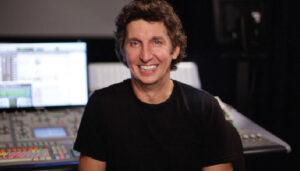
Can “Stranger Things” top itself in the coming Season 4? The editors, who have the benefit of watching raw performances come through the transom in dailies, are adamant that the success of the series rests with the cast more than pyrotechnics. “They’re all such great actors,” said Naranjo, adding that when performers flub a line, instead of resetting, the directors on “Stranger Things” usually keep rolling.
“Whether it be Shawn or the Duffers, they just keep going and keep the momentum going,” Naranjo said. “To watch that, as an assistant and as an editor, and see, ‘OK, this is where they were trying to get to.’” Seeing actors refine their work over the course of an uninterrupted take also gives the editor insight into where a performance is headed. “If something is not working one way, then an editor is able to finesse it,” she said. The results, Levy said, show up on the screen. Added Levy: “Our editing team has phenomenal taste and instincts in selecting and assembling the very best moments from each cast member.”

But if you want a better idea about the deep and wide appeal of “Stranger Things,” don’t just take the word of the makers of the show. Just listen, as Zimmerman does, to the show’s countless fans. You can find them on fan reaction videos on YouTube — the surest proof that Zimmerman and his colleagues aren’t alone in their ’80s fandom.
“One of my guilty pleasures is watching those people who kind of videotape themselves watching the episodes,” Zimmerman said. “Then cut to me in the cutting room — sobbing like a baby.”



